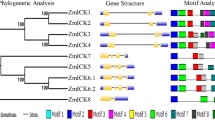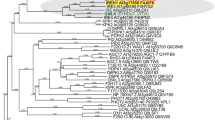Abstract
The mitogen activated protein (MAP) kinase pathway of eukaryotes is stimulated by many growth factors and is required for the integration of multiple cellular signals. In order to study the function of MAP kinases during plant ovule development we have synthesized a Petunia hybrida ovule-specific cDNA library and screened for MAP protein kinase-related sequences using a DNA probe obtained by PCR. A full-length cDNA clone was identified (PMEK for Petunia hybrida MAP/ERK-related protein kinase) and shown to encode a protein related to the family of MAP/ERK protein kinases. Southern blot analysis showed that PMEK is a member of a small multigene family in P. hybrida. The cDNA codes for a protein (PMEK1) of 44.4 kDa with an overall sequence identity of 44% to the products of the mammalian ERK/MAP kinase gene, and the budding yeast KSS1 and FUS3 genes. PMEK1 displays 96 and 80% identity respectively with the tobacco NTF3 and Arabidopsis ATMPK1 kinases, and only 50% to the more distantly related plant MAP kinase MsERK1 from alfalfa. The two phosphorylation sites found in the loop between subdomain VII and VIII in all the other MAP kinases are also present in PMEK1. RNA gel blot and RT-PCR analyses demonstrated that PMEK1 is expressed in vegetative organs and preferentially accumulated in female reproductive organs of P. hybrida. In situ hybridization experiments showed that in the reproductive organs PMEK1 is expressed only in the ovary and not in the stamen.
Similar content being viewed by others
References
Anderson NG, Maller JL, Tonks NK, Sturgill TW: Requirement for integration of signals from two distinct phosphorylation pathways for activation of MAP Kinase. Nature 343: 651–653 (1990).
Banno H, Hirano K, Nakamura T, Irie K, Nomoto S, Matsumoto K, Machida Y: NPK1, a tobacco gene that encodes a protein with a domain homologous to yeast BCK1, STEII and Byr2 protein kinases. Mol Cell Biol 13: 4745–4752 (1993).
Boulton TG, Nye SH, Robbins DJ, Ip NY, Radziejewska E, Morgenbesser SD, DePinho RA, Panayotatos N, Cobb MH, Yancopoulos GD: ERKs, a family of protein-serine/threonine kinases that are activated and tyrosine phosphorylated in response to insulin and NGF. Cell 65: 663–675 (1991).
Boutry M, Chua NM: A nuclear gene encoding the beta subunit of the mitochondrial ATP synthase in Nicotiana plumbaginifolia. EMBO J 4: 2159–2165 (1994).
Brand AH, Perrimon N: Raf acts downstream of the EGF receptor to determine dorsoventral polarity during Drosophila oogenesis. Genes Devel 8: 629–639 (1994).
Chen TH, Sarnecki C, Blenis J: Nuclear localization and regulation of ERK- and RSK-encoded protein kinases. Mol Cell Biol 12: 915–927 (1992).
Chirgwin JM, Przybyla AE, McDonald RJ, Rutter MJ: Isolation of biologically active ribonucleic acid from sources enriched in ribonucleases. Biochemistry 18: 5294–5299 (1979).
Chung J, Pelech SL, Blenis J: Mitogen-activated Swiss 3T3 RSK kinases I and II are related to pp44mpk from sea star oocytes and participate in the regulation of pp90rsk activity. Proc Natl Acad Sci USA 88: 498 (1991).
Cox KH, Goldberg RB: Analysis of plant gene expression. In: Shaw CH (ed) Plant Molecular Biology: A Practical Approach, pp. 1–34, IRL Press, Oxford (1988).
Dellaporta S, Wood LJ: A plant DNA minipreparation, Version II. Plant Mol Biol Rep 1: 19–21 (1983).
DePaepe R, Forchioni A, Chétrit P, Vedel F: Specific mitochondrial proteins in pollen: presence of an additional ATP synthase β subunit. Proc Natl Acad Sci USA 90: 5934–5938 (1993).
deVries SC, Hoge H, Bisseling T: Isolation of total and polysomal RNA from plant tissues. In: Gelvin SB, Schilperoort RA (eds) Plant Molecular Biology Manual, pp. B6: 1–13. Kluwer Academic Publishers, Dordrecht, Netherlands (1988).
Duerr B, Gawienowski M, Ropp T, Jacobs T: MsERK1, a mitogen-activated protein kinase from a flowering plant. Plant Cell 5: 87–96 (1993).
Errede B, Levin DE: A conserved kinase cascade for MAP kinase activation in yeast. Curr Opin Cell Biol 5: 254–260 (1993).
Ferrant V, VanWent J, Kreis M: Ovule cDNA clones of Petunia hybrida encoding proteins homologous to MAP and shaggy/zeste-white 3 protein kinases. In: Scott R, Stead A (eds) Molecular and Cellular Aspects of Plant Reproduction, pp. 159–172, Cambridge University Press, Cambridge, UK (1994).
Gartner A, Nasmyth K, Ammener G: Signal transduction in Saccharomyces cerevisiae requires tyrosine and threonine phosphorylation of Fus3 and KSS1. Genes Devel 6: 1280–1292 (1992).
Gille H, Sharrocks AD, Shaw PE: Phosphorylation of transcription factor p62TCF by MAP kinase stimulates ternary complex formation at c-fos promoter. Nature 358: 414–417 (1992).
Hanks SK, Quinn AM, Hunter T: The protein kinase family: conserved features and deduced phylogeny of the catalytic domains. Science 241: 42–52 (1988).
Hanks SK: Eukaryotic protein kinases. Curr Opin Struct Biol 1: 369–383 (1991).
Hanks S, Quinn AM: Protein kinase catalytic domain; sequence database. Meth Enzymol 200: 38–61 (1991).
Hilson P, DeFroidmont D, Lejour C, Hirai S-I, Jacquemin J-M, Moshe Y: Fos and Jun oncogenes transactivate chimeric or native promoters containing AP1/GCN4 binding sites in plant cells. Plant Cell 1: 651–658 (1990).
Hughes DA: Histidine kinases hog the limelight. Nature 369: 187–188 (1994).
Hunter T, Karin M: The regulation of transcription by phosphorylation. Cell 70: 375–387 (1992).
Janknecht R, Ernst WH, Pingoud V, Nordheim A: Activation of ternary complex factor Elk-1 by MAP kinases. EMBO J 12: 5097–5104 (1993).
Jonak C, Kiegerl L, Bögre L, Heberle-Bors E, Hirt H: A MAP kinase gene family in alfalfa. 4th International Congress of Plant Molecular Biology, Amsterdam, 19–24 June (1994).
Jonak C, Pay A, Bögre L, Hirt H, Heberle-Bors E: The plant homologue of MAP kinase is expressed in a cell cycle-dependent and organ-specific manner. Plant J 3: 611–617 (1993).
Lin LL, Wartmann M, Lin AY, Knopf J, Seth A, Davis R: cPLA2 is phosphorylated and activated by MAP kinase. Cell 72: 269–278 (1993).
Lütcke HA, Chow KC, Mickel FS, Moss KA, Kern HF, Scheete GA: Selection of AUG initiation codons differs in plants and animals. EMBO J 6: 43–48 (1987).
Marshall CJ: Hot lips and phosphorylation of protein kinases. Nature 367: 686 (1994).
Mizoguchi T, Hayashida N, Yamaguchi-Shinozaki K, Kamada H, Shinozaki K. ATMPKs, a gene family of plant MAP kinases in Arabidopsis thaliand. FEBS Lett 336: 440–444 (1993).
Mizoguchi T, Gotoh Y, Nishida E, Yamaguchi-Shinozaki K, Hayashida N, Iwasaki T, Kamada H, Shinozaki K: Characterization of two cDNAs that encode MAP kinase homologues in Arabidopsis thaliana and analysis of the possible role of auxin in activating such kinase activities in cultured cells. Plant J 5: 111–122 (1994).
Nebrada AR, Hunt T: The c-mos proto-oncogene protein kinase turns on and maintains the activity of MAP kinase, but not MPF, in cell-free extracts of Xenopus oocytes and eggs. EMBO J 12: 1979–1986 (1993).
Neimann AM: Conservation and reiteration of a kinase cascade. Trends Genet 9: 390–394 (1993).
Payne MD, Rossomando AJ, Martino AK, Erickson AK, Her J-H, Shabanowitz J, Hunt DF, Weber MJ, Sturgill TW: Identification of the regulatory phosphorylation sites in pp42/mitogen-activated protein kinase (MAP kinase). EMBO J 10: 885–892 (1991).
Pelech SL: Networking with protein kinases. Curr Biol 3: 513–515 (1993).
Posada J, Yew N, Ahn NG, VandeWoude GF, Cooper JA: Mos stimulates MAP kinase in Xenopus oocytes and activates a MAP kinase in vitro. Mol Cell Biol 13: 2546–2553 (1993).
Preat T, Thérond P, Lamour-Isnard C, Limbourg-Bouchon B, Tricoire H, Erk I, Mariol MC, Busson D: A putative serine/threonine protein kinase encoded by the segment-polarity gene fused in Drosophila Nature 347: 87–89 (1990).
Pulverer BJ, Kyriakis JM, Avruch J, Nikolakaki E, Woodgett JR: Phosphorylation of c-jun mediated by MAP kinases. Nature 353: 670–674 (1991).
Sanger F, Nicklen S, Coulson AR: DNA sequencing with chain-terminating inhibitors. Proc Natl Acad Sci USA 74: 5463–5467 (1977).
Seth A, Alvarez E, Gutpa S, Davis RJ: A phosphorylation site located in the NH2-terminal domain of c-myc increases transactivation of gene expression. J Biol Chem 266: 23521–23524 (1991).
Stafstrom JP, Altschuler M, Anderson DH: Molecular cloning and expression of a MAP kinase homologue from pea. Plant Mol Biol 22: 83–90 (1993).
Stokoe D, Campbell DG, Nakielny S, Hidaka H, Leevers SJ, Marshall C, Cohen P: MAPKAP kinase-2; a novel protein kinase activated by mitogen-activated protein kinase. EMBO J 11: 3985–3994 (1992).
vanEngelen FA, Hartog MV, Thomas TL, Taylor B, Sturm A, vanKammen A, deVries SC: The carrot secreted glycoprotein gene EP1 is expressed in the epidermis and has sequence homology to Brassica S-locus glycoproteins. Plant J 4: 855–862 (1993).
vanWent J, Kwee H-S: Enzymatic isolation of living embryo sacs of Petunia. Sex Plant Reprod 3: 257–262 (1990).
Wilson C, Eller N, Gartner A, Vicent O, Heberle-bors E: Isolation and characterization of a tobacco cDNA clone encoding a putative MAP kinase. Plant Mol Biol 23: 543–551 (1993).
Zhang F, Strand A, Robbins D, Cobb MH, Goldsmith EJ: Atomic structure of the MAP kinase ERK2 at 2.3 Å resolution. Nature 367: 704–711 (1994).
Author information
Authors and Affiliations
Rights and permissions
About this article
Cite this article
Decroocq-Ferrant, V., Decroocq, S., Van Went, J. et al. A homologue of the MAP/ERK family of protein kinase genes is expressed in vegetative and in female reproductive organs of Petunia hybrida . Plant Mol Biol 27, 339–350 (1995). https://doi.org/10.1007/BF00020188
Received:
Accepted:
Issue Date:
DOI: https://doi.org/10.1007/BF00020188




